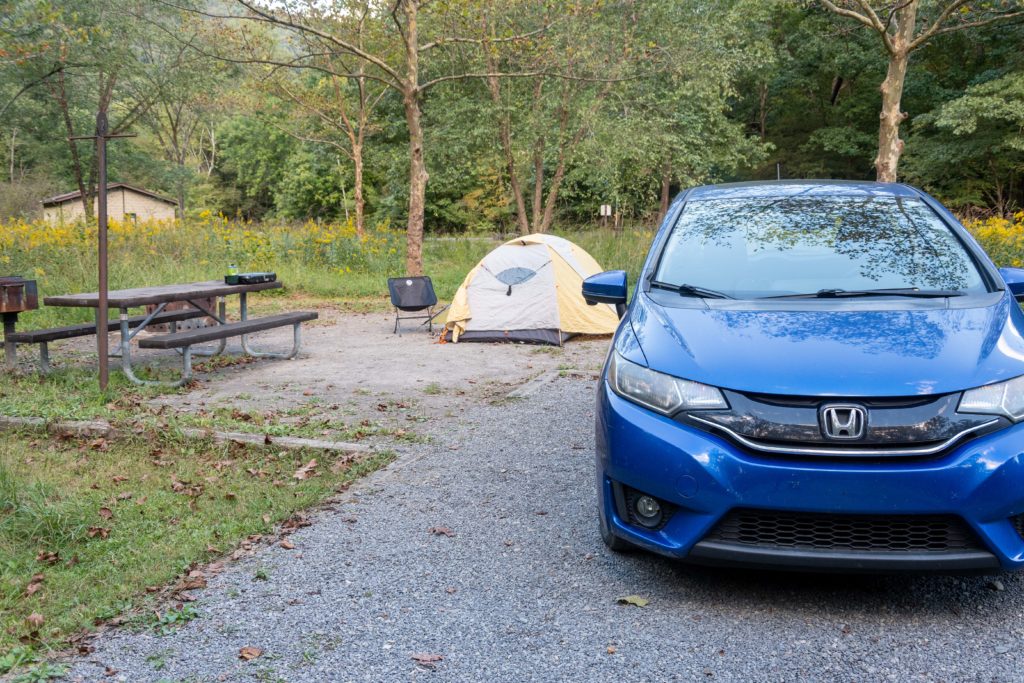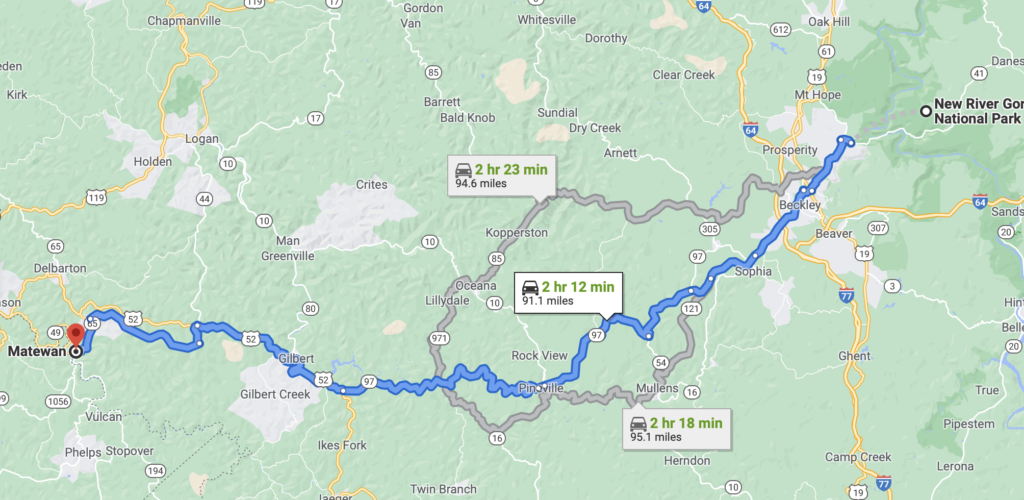I spent my last night in Royal Gorge National Park camped at a nice little spot called Army Camp, which was so quiet that I could hear the New River running nearby.

Friday morning I made myself a nice breakfast of oatmeal with coffee and then headed out westbound.
Towards Matewan.
Most of the drive was uneventful. Gorgeous, but uneventful. The best kind of drive, really. But things got a little interesting around the town Gilbert.

I was looking for a place to get gas. Not that I needed it yet, but the Fit has such a tiny gas tank that I get a little paranoid. Even with the great gas mileage I get less than 400 miles (highway) on a single tank. And when you’re new to an area, it can be hard to tell how far apart the towns are, and which of these tiny towns will actually have a gas station. Spotty cell service does not help.
Anyway. Around Gilbert I started noticing a serious uptick in ATVs. On the road, in parking lots and campgrounds. And clustered at gas stations. As in, they took up every pump. Every gas station in Gilbert had so many ATVs that there was nowhere for me to pull in.
I also started to see signs for something called the Hatfield-McCoy Trails. The local campgrounds boasted direct access and every sign said “welcome ATVs!”
Turns out the Hatfield-McCoy Trails are a nationally known, multi-country trail network that is most popular for its ATV trails, although I learned this a bit later. At the time I made a mental note and moved on, and was eventually able to get gas with nary an ATV in sight.
I arrived in Matewan with a very specific purpose: the West Virginia Mine Wars Museum. It’s housed in the former Matewan National Bank and details a specific time period in West Virginia history, from about 1900 into the early 1920s. I’ve been putting off writing this post (for months, embarrassingly, as I was there in September and it’s now December) because I’m still quite conflicted. There’s so much information out there, I could write a book. Except I don’t have to, as several books have been written about Mine Wars. So how to distill all that information into a blog post?
Let’s stick with some facts.
- Around the turn of the last century, coal was king and responsible for the industrial revolution in the US. Coal mines were the number one money maker in West Virginia. That meant that the mining companies controlled everything.
- The Mine Wars were a series of conflicts caused when the miners wanted to unionize, along with better pay and benefits. The mining companies absolutely did not want this to happen. They used armed guards (called “detectives”) to prevent the miners from meeting and organizing. The miners then used guerrilla warfare towards their goals. There were actual gunfights, including one right in downtown Matewan. People died.
- The West Virginia Mine Wars are considered the largest insurrection in U.S. history outside of the Civil War, which is probably why the National Guard was called in. It was the only way to get everyone to stop shooting each other.
- The term “redneck” originally applied to people who showed their support of the miners by wearing red bandanas around their necks. (Mine company supporters wore white armbands.)
The museum was amazingly cool and informative. I was most fascinated by the individual stories though, and particularly stories from the women involved. There are many audio files you can listen to here. My favorite was that of a young miner’s wife who became a gunrunner for the miners – while pregnant.
Her family had no car so they walked everywhere. It was winter so she wore this big, heavy coat. And she’d hang a shotgun under each arm and put a handfull of shells in each pocket, then walk right past those company detectives and deposit all the weapons in a hiding spot in town. Nobody wanted to search a pregnant girl!
I left the Museum with a huge amount of new knowledge and a small trove of books for further investigation. Kim, the docent at the museum that day, was the one who let me know about the Hatfield-McCoy Trails. When I mentioned those gas stations full of ATV-ers, she said, “Yeah. Imagine living here.”
I had a long drive after Matewan – about 5 hours to Mammoth Caves National Park in Kentucky. I drove through Muhlenberg County and spent the next hour singing Paradise by John Prine. In fact, I realized that Kentucky is the basis for many folk and bluegrass songs I know and love. That did make the drive a little easier.
Next post: Mammoth Caves National Park!